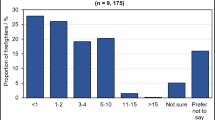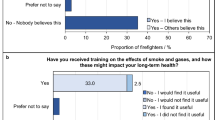Abstract
Within the biomedical research industry, people who work with laboratory animals may be at risk of developing laboratory animal allergy, which can lead to occupational asthma. Under UK and EU laws, employers must prevent or adequately control exposure to any hazardous substance, which includes animal allergens, so far as reasonably practicable, for the protection of all people on the premises. This can be achieved in part by reviewing the risk of allergen exposure in specific areas of a facility and implementing appropriate infrastructure, environmental and performance controls to minimize that risk. The authors describe the approach used at their institution to stratify risk of allergen exposure in various areas of the animal facility and to implement appropriate controls. They also discuss their use of a monitoring program to evaluate allergen concentrations in low- and high-risk areas of the animal facility and explain how the monitoring results can be applied to determine which controls are needed to minimize risk of exposure and to provide a safe working environment.
This is a preview of subscription content, access via your institution
Access options
Subscribe to this journal
We are sorry, but there is no personal subscription option available for your country.
Buy this article
- Purchase on Springer Link
- Instant access to full article PDF
Prices may be subject to local taxes which are calculated during checkout



Similar content being viewed by others
References
Lincoln, T.A., Bolton, N.E. & Garrett, A.S. Occupational allergy to animal dander and sera. J. Occup. Med. 16, 465–469 (1974).
Lutsky, I.I. & Neuman, I. Laboratory animal dander allergy. I. An occupational disease. Ann. Allergy 35, 201–205 (1975).
Taylor, G. et al. Allergic reactions to laboratory animals. Nature 260, 280 (1976).
Gordon, S. & Preece, R. Prevention of laboratory animal allergy. Occup. Med. (Lond.) 6, 371–377 (2003).
Folletti, I., Forcina, A., Marabini, A., Bussetti, A. & Siracusa, A. Have the prevalence and incidence of occupational asthma and rhinitis because of laboratory animals declined in the past 25 years? Allergy 63, 834–841 (2008).
Gordon, S. Laboratory animal allergy: a British perspective on a global problem. ILAR J. 41, 37–46 (2001).
Nicholson, P.J., Mayho, G.V., Roomes, D., Swann, A.B. & Blackburn, B.S. Health surveillance of workers exposed to laboratory animal allergens. Occup. Med. (Lond.) 60, 591–597 (2010).
Renström, A., Björing, G. & Höglund, A.U. Evaluation of individually ventilated cage systems for laboratory rodents: occupational health aspects. Lab Anim. 35, 42–50 (2001).
Schumacher, M.J. Characterization of allergens from urine and pelts of laboratory mice. Mol. Immunol. 17, 1087–1095 (1980).
Renström, A., Karlsson, A.S., Malmberg, P., Larsson, P.H. & van Hage-Hamsten, M. Working with male rodents may increase risk of allergy to laboratory animals. Allergy 56, 964–970 (2001).
Matsui, E.C. Role of mouse allergens in allergic disease. Curr. Allergy Asthma Rep. 9, 370–375 (2009).
Wood, R.A. Laboratory animal allergens. ILAR J. 42, 12–16 (2001).
Schweitzer, I.B. et al. Reducing exposure to laboratory animal allergens. Comp. Med. 53, 487–492 (2003).
Peng, R.D. et al. Both the variability and level of mouse allergen exposure influence the phenotype of the immune response in workers at a mouse facility. J. Allergy Clin. Immunol. 128, 390–396 (2011).
COSHH. The Control of Substances Hazardous to Health Regulations 2002 (as amended). Approved code of practice and guidance L5 (sixth edition). London: HSE Books, (2013).
British Standards Institution. EN149:2001. Respiratory protective devices. Filtering half masks to protect against particles. Requirements, testing, marking. London: BSI, (2001).
Health & Safety Executive. Control of laboratory animal allergy. Guidance Note EH76. London: HSE Books, (2011).
Phipatanakul, W., Eggleston, P.A., Wright, E.C. & Wood, R.A. Mouse allergen. I. The prevalence of mouse allergen in inner-city homes. The National Cooperative Inner-City Asthma Study. J. Allergy Clin. Immunol. 106, 1070–1074 (2000).
Acknowledgements
We thank the staff at The Cube Ltd. for collecting and processing all of the samples and for helpful discussions, and we thank the staff of the Sanger Institute Research Support Facility for participating in the monitoring studies.
Author information
Authors and Affiliations
Corresponding author
Ethics declarations
Competing interests
The authors declare no competing financial interests.
Rights and permissions
About this article
Cite this article
Westall, L., Graham, I. & Bussell, J. A risk-based approach to reducing exposure of staff to laboratory animal allergens. Lab Anim 44, 32–38 (2015). https://doi.org/10.1038/laban.603
Received:
Accepted:
Published:
Issue Date:
DOI: https://doi.org/10.1038/laban.603
This article is cited by
-
Occupational Animal Allergy
Current Allergy and Asthma Reports (2018)
-
Laboratory Animal Allergy in the Modern Era
Current Allergy and Asthma Reports (2015)



